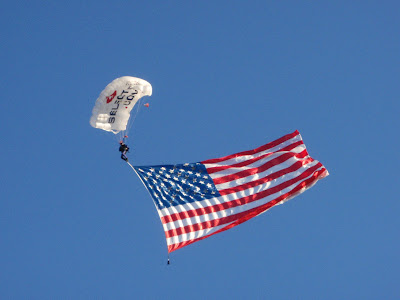 |
| From Tunica_ScoutBase2010 |
No matter the location, it's impressive to see these legions of scouts encamped at the jamboree events. Tent cities arise in a matter of a few hours, complete with physical infrastructure, civic services, neighborhoods, and commerce. We begin to imagine what armies of yore must have looked like when on campaign. It's also interesting to note the prevalence of Coleman tents, lanterns and kitchen gear in these scout campaigns... particularly when it comes to the kitchen gear, the scouts are well-equipped and provisioned. Napoleon knew that a battle-ready army marches on its stomach. Today's scouts are no exception, and the food prep area is more often than not the center of scout activity. For our part, we are appreciative. More than once we've been the grateful recipients of a generously shared meal (see earlier blog entitled "Bleu in the Blue Grass State").
We've also been wowed by the Scouts' management of logistics for the diverse exhibitry at these jamborees. In Tunica, we had a great location for our e-Tour booth at the intersection of two main pedestrian boulevards through the exhibit area. We were next to a row of livestock pens in the expansive open-air shelter, just across from the popular NASA exhibit (cool space-age ink pens and Star Trekky badges with flashing LEDs). A few steps down from us was the booth promoting "Elvis Presley's Graceland Mansion." We're talking strategic placement for sure... Shaded from sun and protected from threat of rain, we had ample room for our Subaru Tribeca billboard, exhibit table, Bigfoot feet and poster, and the hordes (and we do mean hordes) of boy scouts, cubs, parents, and Council staff who visited. The crowds impressed us as being extraordinarily friendly, and time and again folks thanked us for bringing the e-Tour to the ScoutBase event.
 |
| From Tunica_ScoutBase2010 |
In addition to the incredibly friendly and thoughtful folks we met at Tunica and every other stop along our way, a most enduring impression stands out: the image of a small child cradled in their parent’s arms, tired and spent from a long day at the festival or jamboree, whose eyes immediately light up in a sparkle as their face is transformed by a sweet, often shy, elfin smile at the offer of a Bigfoot sticker. Now that’s the kind of pleasant and poignant sensation that we’re bound to carry with us as we travel down the road. Who knows what Leave No Trace magic our gentle Bigfoot mascot might work in the mind of a child. Safe to say, we’re confident that during our travels we’ve met innumerable outdoor ethics champions of the future.
 |
| From Tunica_ScoutBase2010 |
Hoping to meet them again along the way… maybe you'll be in their good company (you could be one of those champions, too).
Peggy and Barrett
2010 Leave No Trace e-Tour
e-Word: "enlumine"

















